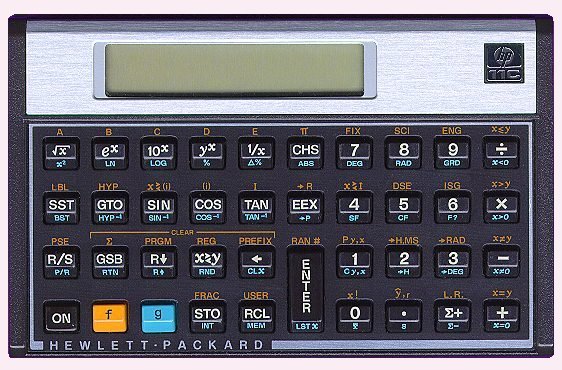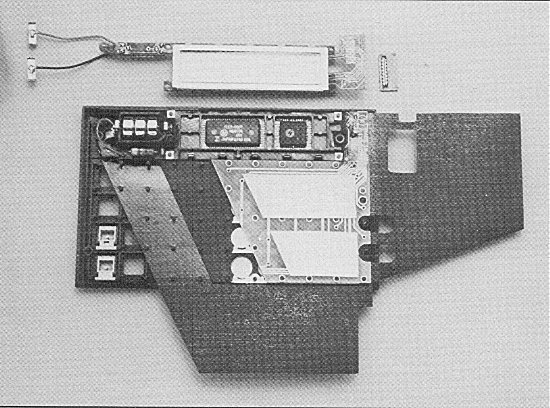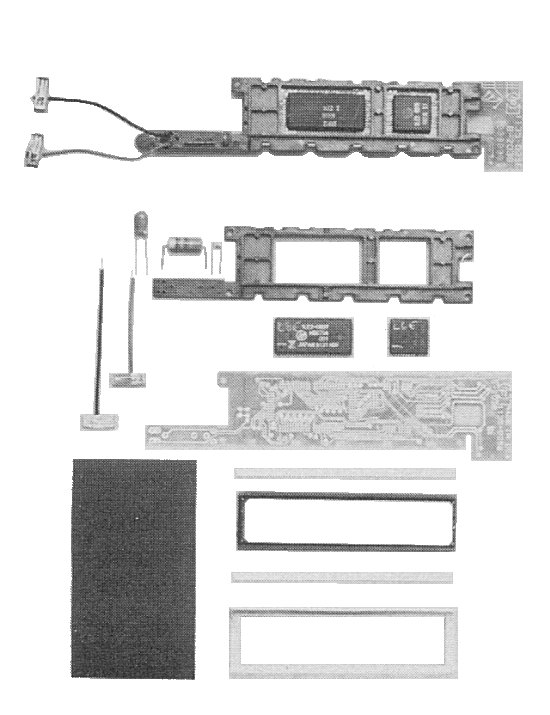

A look inside Hewlett-Packard's HP-11C
(since April 22, 1997)
Last Update: August 14, 2021 -- THE HP REFERENCE
ELECTRONIC PACKAGING and PRODUCTION Magazine
MARCH, 1982
pp 157-158
By Howard W. Markstein, Western Editor
Hewlett-Packard engineers have employed the latest packaging
technology in designing the HP-11C, a programmable calculator
with an extensive set of built-in scientific and engineering
functions.
The HP 11C pocket calculator (Fig. 1) from Hewlett-Packard is a study
in packaging efficiency. A large-face LCD module, battery pack and
high-reliability keyboard are all interconnected and housed in a
slimline ABS plastic case measuring 5 x 3 1/8 x 5/8 inches. Figure 2
shows the major parts within the HP-11C.
Russ Paglia, senior design engineer for the HP-11C, says a major
challenge in the design was in maximizing the usefulness of the LCD.
"We changed the format from that of our previous calculators by using
a larger LCD for displaying bigger, bolder characters," explains Paglia.
"The display window is 2.375 x 0.500 in. but the glass LCD device
overlaps the window size around the edge by about 0.125 inches."
The primary electronics of the HP-11C is located in the display module
(Fig. 3). This module consists of the LCD, a Kapton flexible circuit
containing the electronics, and a plastic backup frame to prevent
defection of the assembly. Two ICs in flatpacks -- the CPU and a
multipurpose chip which drives the display -- are soldered to the flexible
circuit together with some analog components for the low battery-
indicator circuit. Two elastomeric connectors, one along the top
edge of the LCD and one along the bottom, interconnect the LCD to the
flexible circuit. The display module is held together by a metal frame
that clips around the periphery of the assembly, effectively
sandwiching the flexible circuit between the LCD and the plastic
frame. The flexible circuit extending from one end of the display
module makes pressure contact with matching fingers on the epoxy glass
keyboard. The flexible circuit extending from the opposite end of the
module has clips for attachment to the battery pack.
1. Hewlett-Packard's new calculator, the HP-11C, is a programmable
instrument for solving complex scientific and engineering functions.
Designed to be a professional tool, the HP-11C also exemplifies
Hewlett-Packard's expertise in electronic packaging.
According to Paglia, the HP-11C has been designed to withstand shock
equivalent to a drop from a shirt pocket on to a hard floor. The
display module floats on a special mounting at its four corners.
Holes at each corner of the display module's plastic backup frame
mate with bosses on the molded case. Urethane foam washers are
placed on each side of the plastic frame to provide the required
cushioning.
The keyboard is a two-sided epoxy glass PC board containing gold-plated
key-contact areas and circuit traces. The keyboard assembly consists
of the plastic keys, a thin rubber spacer to take up slack and
eliminate key rattle, stainless steel switching actuators, and the
rigid PC board. This entire assembly is inserted into the HP-11C's
front half of the case and is aligned and supported by mating a set
of holes in the keyboard with boss extensions on the molded case.
Once in place, the bosses are heat-deformed to permanently attach
the keyboard assembly to the case.
2. A view of the HP-11C with rear cover removed shows the keyboard in
a cutaway section. Black film around keyboard is a conductive
polycarbonate wrapping. Display module (also shown Separate at top)
mounts in the upper section adjacent to batteries at left.
3. The assembled display module (rear view) is shown at top Parts
from top down are backup frame. ICs, flexible circuit, two elastomeric
connectors, LCD, and metal frame. At lower right is conductive
polycarbonate overlay for covering the rear and sides of the module.
Hewlett-Packard engineers have provided a high degree of electrostatic
protection for the HP-11C and its sensitive CMOS devices. A thin film
of mylar-coated conductive polycarbonate is used for covering the back
of the display module. The keyboard is also wrapped with the conductive
polycarbonate film and bonded to an adhesive-coated foam tape on the
back of the keyboard. This provides electrostatic protection as well as
a seal against contamination.
The two halves of the ABS plastic case mate along an inclined interface,
forming an efficient seal against the ingress of dust or moisture. Four
screws installed from the back firmly secure the two halves.
The Calculator Reference by Rick Furr (rfurr@vcalc.net)
Back to The HP Page
Back to The Calculator Reference






